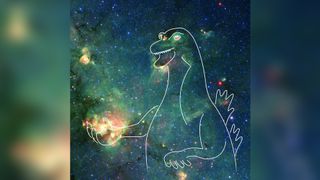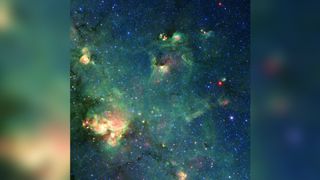Does this 'Godzilla' nebula really look like a space lizard?
What do you see in the photo?

What do you see in this image of space gas and dust? Perhaps, the greenish blob puts you in mind of a frog, or a crocodile, or Slimer from "Ghostbusters." One scientist is pretty sure he saw Godzilla.
Much like clouds on Earth, space clouds can trigger pareidolia, the recognition of a face or familiar object in an ambiguous pattern. And the Godzilla nebula, which sort of looks like the space lizard, but potentially like any other number of objects, is a prime example of the phenomenon.
Caltech astronomer Robert Hurt, who catalogs images from NASA's Spitzer Space Telescope, is used to experiencing this phenomenon on his forays through Spitzer imagery.
Related: 13 bizarre mythical monsters to haunt Your Halloween

"I wasn't looking for monsters," Hurt said in a statement. "I just happened to glance at a region of sky that I've browsed many times before, but I'd never zoomed in on. Sometimes if you just crop an area differently, it brings out something that you didn't see before. It was the eyes and mouth that roared 'Godzilla' to me."
The nebula has now been added to Spitzer's Artistronomy Web App, where users can sketch their own pareidolia-fueled imaginings over nebula images from the space telescope. Spitzer was retired in January 2020, but its 17 years of imagery has left scientists with lots of data to comb through. The telescope strips away visible light to reveal the universe in infrared, wavelengths longer than the human eye can detect. This infrared imagery reveals gaseous structures that are usually obscured by dust.
In this imagery, blue and cyan (blue-green) are infrared wavelengths emitted by stars, according to NASA. Green represents dust and organic hydrocarbon molecules. Red areas are dust that has been heated by stars or stellar explosions known as supernovas. It just so happens that a couple of those super-heated spots look a bit like the eyes of a radioactive lizard that wants to stomp on Tokyo.
Sign up for the Live Science daily newsletter now
Get the world’s most fascinating discoveries delivered straight to your inbox.
This space monster is actually in the constellation Sagittarius. The stars that make up Godzilla's nose and eyes are within the Milky Way, though their distance from Earth isn't known. The bright region at the lower left, which Hurt imagines as Godzilla's outstretched claw, is a star-forming region called W33. The particularly bright pinpoints of light in this region are nascent stars that are beginning to form, but which haven't yet carved away the surrounding gas and dust.
If Godzilla isn't your cup of tea, there are plenty of other spooky nebulas to choose from: The 'Skull and Bones' nebula, for example, or a ghostly Cassiopeia , or a skull-like glowing face. There's even a Halloween-appropriate bat swooping out from behind the constellation Orion.
Originally published on Live Science.

Stephanie Pappas is a contributing writer for Live Science, covering topics ranging from geoscience to archaeology to the human brain and behavior. She was previously a senior writer for Live Science but is now a freelancer based in Denver, Colorado, and regularly contributes to Scientific American and The Monitor, the monthly magazine of the American Psychological Association. Stephanie received a bachelor's degree in psychology from the University of South Carolina and a graduate certificate in science communication from the University of California, Santa Cruz.
Most Popular

